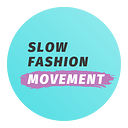Slow Fashion Movement — From a Season to a Movement, from a Movement to a NGO
As the proverb says ‘Great oaks from little acorns grow’ -an apt phrase for the impressive growth of the Slow Fashion Movement in a relatively short space of time.
The story begins back in 2018 when members of a Dutch NGO called CollAction, a crowdaction platform, pledged not to buy any new clothes for three months. CollAction’s tag line was ‘Building people power to transform the fashion industry’.
Whilst the pledge was initially agreed amongst friends and colleagues, the crowdaction campaign ignited a spark in people across the world who were tired of the relentless pace of the fast fashion industry and its impact on both workers and the environment. This initial low-key campaign was a huge success, resulting in 2,500 people abiding by the decision to buy no new clothes for three months, and participating in the first ever ‘Slow Fashion Summer’.
Slow Fashion Season started to run from July to September as an annual fixture on the calendar. The concept was quite simple; no new clothes would be purchased during that time and participants were encouraged to reuse existing clothing, swap and borrow, repair damaged clothing, make pieces and purchase pre-loved clothing.
The aim of the 2019 crowd-acting campaign was to build on the initial success and persuade 10,000 participants to sign up. The campaign proved hugely popular. Citizens across the globe were reached and 13,500 people from 128 countries decided to join CollAction’s Slow Fashion Summer.
The success of the social media-led campaign was incredible. During the course of Slow Fashion Season 2020, 30,000 people across the globe signed up to take part. Buoyed up by such a successful outcome and a now global reach, Slow Fashion Season expanded in November 2020 to become Slow Fashion Movement, a global volunteer-led group which would introduce multiple campaigns across the year. Its initial vision statement was to ‘envision a world in which fashion has a healing impact on the environment and those who make our clothes’.
The objective of Slow Fashion Movement was to end fast fashion as soon as possible by:
● Slowing down consumption and production
● Making better long-lasting clothes
● Being fair to the people who work in the garment industry
Slow Fashion Movement would be a politically active community providing a global platform where people could work together to educate and transform the fashion community.
Within its first year, 16 Slow Fashion Movement national teams and 88 of its ambassadors signed up to support the movement and various well-received campaigns were organised. This included #CutTheSeasons that aimed to reduce over-production by big fast fashion brands, the #GreenFridayChallenge encouraging participants to shop their closet rather than participating in Black Friday and #ConsciousCarnival which visited different cultures around the world in a celebration of tradition, cultural heritage and creativity.
In April 2021, the #KnowYourJeans campaign was launched. It highlighted the impact of the denim industry on both the planet and its people and focused on #HappyJeans that were produced more sustainably and avoided harmful chemical and production processes, and #SadJeans, which are mass produced jeans that are damaging to the environment. This was followed by Slow Fashion Season 2021 #FashionDetox — yet another crowd-acting campaign aiming to persuade 20,000 people to sign up to buying no fast fashion from July to September.
The figure of 20,000 was not plucked out of thin air- if this number of people would commit to purchasing no new clothes for three months a staggering 750 million litres of water and 2.5 million kilograms of CO2 emissions could be saved.
Valuable partnerships were also forged. In May 2021, Slow Fashion Movement partnered with the Conscious Fashion and Lifestyle Network to support United Nations’ Sustainable Development Goals — a call foraction for countries to ‘promote prosperity while protecting the planet’. In support of Fashion Revolution, Slow Fashion Movement took a stand against Black Friday, highlighting the environmental effects caused by over-production, over-consumption and waste and reminding people that the most sustainable garment is the one already in their closet.
In 2022, Slow Fashion Movement became a registered NGO with headquarters in the Netherlands. It now has more than 20 local groups and over 150 global ambassadors. This NGO continues to run thought-provoking campaigns and to grow globally, with a current community of over 51.5k people.
From its initial mission in 2018 to refrain from buying new clothing for three months, it now seeks to educate and empower fashion consumers to make environmentally and socially conscious choices. It envisions, and strives for, a fashion ecosystem that protects the physical well-being of the planet and its people.
SFM has always believed in ‘building people power to transform the industry’ and we’re hoping that you’ll join us for Slow Fashion Season 2022, beginning in September. This campaign will look a little different from before and will run for one month only.
As usual, we’ll be encouraging you to refrain from buying new clothes, but we’ll also be encouraging you to dig a little deeper into slow fashion and supporting you with educational content, videos, local and national events, and exciting collaborations. Follow us on Instagram @slowfashion.movement to hear about all the exciting events as they are announced!
By Donna Gilbert
